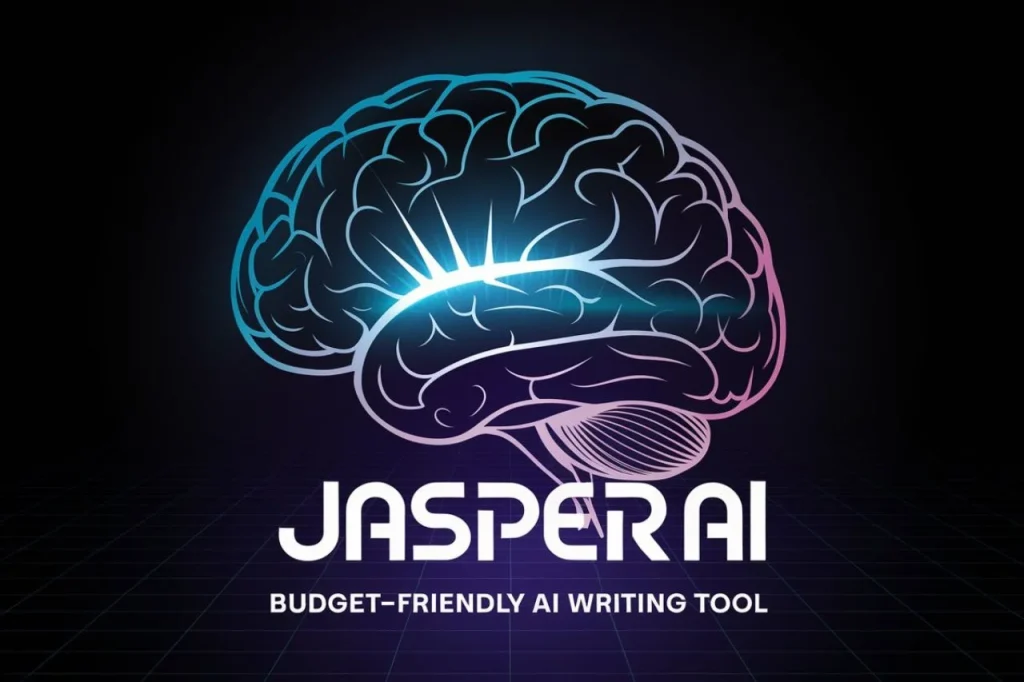
Looking for an AI tool for audible to text? Discover how this powerful solution can save time, improve accuracy, and simplify your workflow.
Introduction
Are you tired of struggling with time-consuming manual transcriptions? An AI tool for audible to text is here to save the day! This revolutionary technology is designed to convert your audio into text effortlessly, providing accuracy, speed, and convenience. Whether you’re a professional transcriber, a content creator, or a student, this tool can simplify your workflow and help you stay productive. In this article, we’ll explore how an AI tool for audible to text works and why it’s a must-have in 2024.
Table of Contents
Why Transcribing Audio Manually is a Challenge
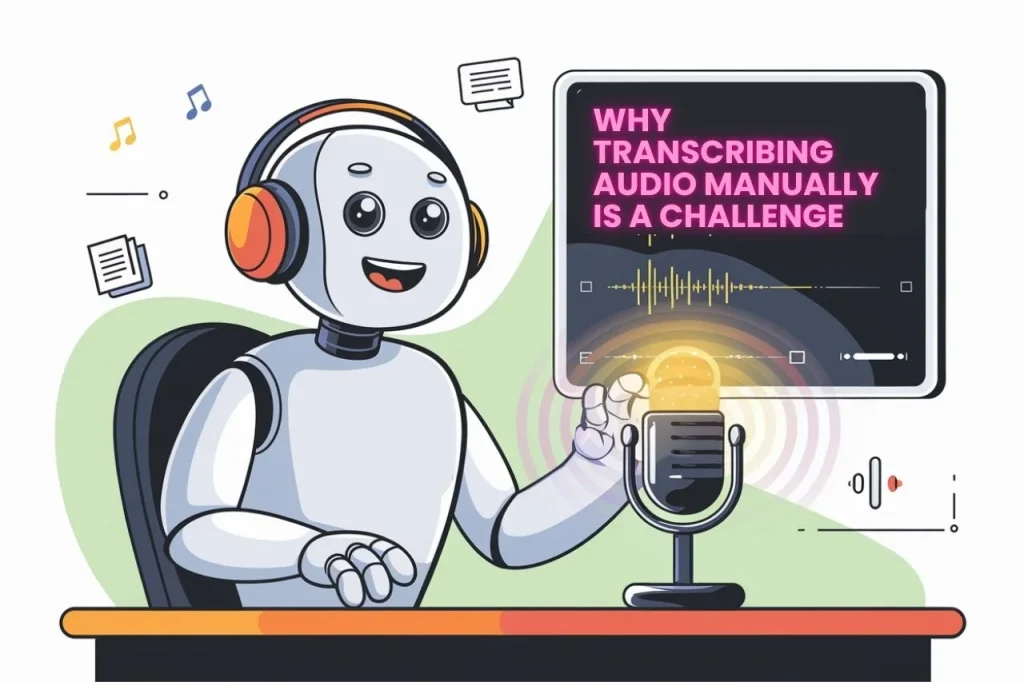
Manually converting audio into text can feel like an uphill battle. Whether it’s for a podcast, meeting, or interview, the process is:
- Time-Consuming: Typing out every word can take hours.
- Prone to Errors: Even the most careful listener may miss important details.
- Mentally Exhausting: Keeping focus on long audio files can lead to fatigue.
If this sounds familiar, don’t worry—you’re not alone!
The Solution: An AI Tool for Audible to Text
Imagine being able to transform your audio files into accurate, readable text within minutes. That’s the power of an AI Tool for Audible to Text! These tools harness advanced artificial intelligence to make transcription faster, more accurate, and stress-free.
With just a few clicks, you can:
- Upload your audio.
- Let AI handle the hard work of converting speech to text.
- Review and use the text for blogs, reports, or meeting notes.
What You’ll Learn in This Guide

This guide is your ultimate resource to:
- Understand the Benefits: Why AI tools are a game-changer for transcription.
- Discover the Best Tools: Detailed reviews and comparisons of top AI tools for audible-to-text transcription.
- Learn How to Use Them: A step-by-step guide to maximize these tools’ potential.
- Pro Tips for Accuracy: Expert tips to ensure the best results every time.
By the end of this article, you’ll have all the knowledge you need to pick the perfect tool and start transcribing like a pro!
Quick Overview
- Are you tired of manual transcription struggles?
- Want to save time and improve productivity?
- Ready to harness the power of AI for your transcription needs?
Let’s dive in and explore how an AI Tool for Audible to Text can revolutionize the way you work with audio content!
Why Use an AI Tool for Audible to Text?
The Challenges of Manual Transcription
Manually transcribing audio files can be a frustrating and time-consuming task. Here’s why it often feels like a struggle:
- Time-Intensive Process:
- Listening to audio repeatedly to ensure accuracy takes hours, especially for long files.
- Pausing and rewinding can disrupt workflow and add unnecessary delays.
- High Risk of Errors:
- Background noise, unclear accents, or fast speech can lead to missed words or misinterpretations.
- Manual transcription often results in inconsistent formatting and missing punctuation.
- Mentally Draining:
- Focusing intently for extended periods can lead to fatigue, decreasing productivity.
If you’ve faced these challenges, you’re not alone. Fortunately, technology has a solution!
Benefits of Using an AI Tool for Audible to Text
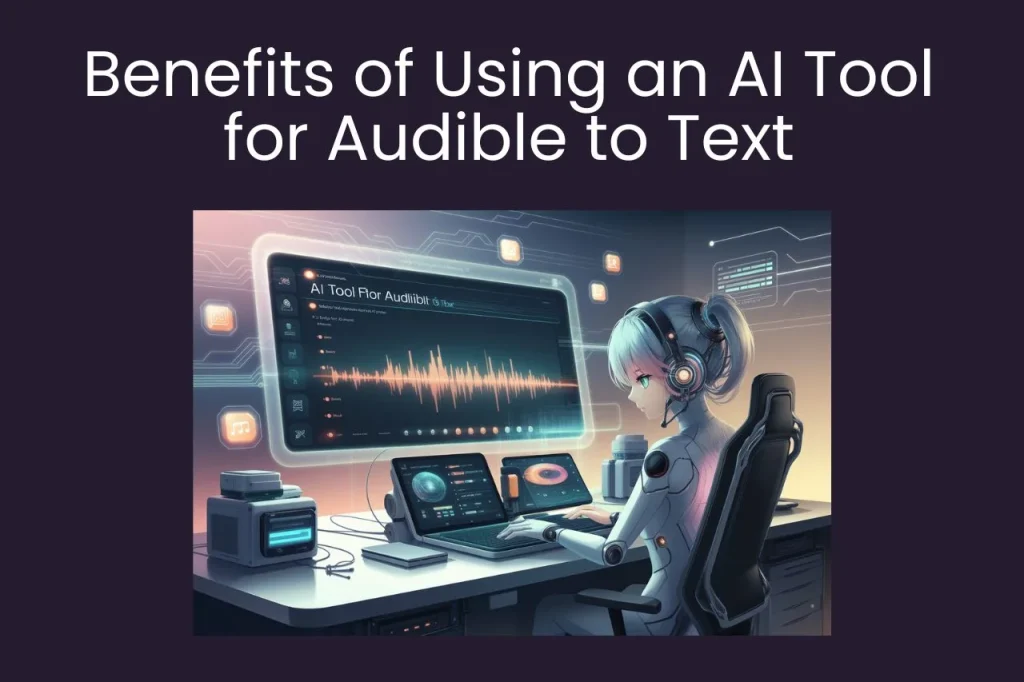
AI-powered tools are revolutionizing transcription by making it faster, easier, and more accurate. Here’s what makes them so effective:
- Fast and Efficient:
- AI tools process audio in minutes, even for lengthy files.
- No need to replay audio multiple times—get instant results.
- Highly Accurate:
- Advanced algorithms identify words with precision, even in complex audio.
- Features like speaker identification and automatic punctuation improve clarity.
- User-Friendly and Accessible:
- Intuitive interfaces make it easy for anyone to use, even without technical skills.
- Many tools support multiple languages, making them globally useful.
Who Benefits the Most from AI Tools for Audible to Text?
AI transcription tools cater to a wide range of users, including:
- Educators:
- Convert lectures into text for students.
- Make learning resources more accessible.
- Journalists:
- Quickly transcribe interviews for articles.
- Ensure every detail is captured accurately.
- Podcasters:
- Create transcripts for SEO-friendly show notes.
- Repurpose content into blogs or captions.
- Business Professionals:
- Generate meeting minutes effortlessly.
- Improve productivity with organized records.
- Students:
- Transcribe lectures or study group discussions for efficient learning.
Why It’s Time to Switch to AI Transcription
Whether you’re a professional or a student, switching to an AI Tool for Audible to Text will save you time and energy while delivering reliable results.
Let AI take care of the tedious work so you can focus on what truly matters—analyzing, sharing, or acting on your content!
How Does an AI Tool for Audible to Text Work?
Technology in Action: How AI Makes Transcription Possible
AI tools for audible-to-text transcription leverage cutting-edge technologies to deliver accurate and efficient results. Here’s how they work:
- Speech Recognition:
- The tool identifies words, phrases, and accents in the audio.
- It converts spoken language into digital text through sophisticated algorithms.
- Natural Language Processing (NLP):
- NLP ensures the transcription isn’t just word-for-word but also contextually accurate.
- It identifies grammatical structures, adds punctuation, and improves readability.
- Machine Learning:
- These tools improve over time by learning from user interactions.
- The more they process, the better their accuracy for accents, languages, and unique speech patterns.
The Step-by-Step Process of Using an AI Tool for Audible to Text
Transcribing audio with an AI tool is as easy as 1-2-3! Here’s a simple breakdown:
- Upload the Audio File:
- Log in to your chosen AI tool.
- Upload your file in a supported format (e.g., MP3, WAV, AAC).
- Processing the Audio:
- The tool analyzes the file using its speech recognition engine.
- It breaks the audio into manageable segments for processing.
- Text Output with Punctuation:
- The AI converts the spoken words into clear, well-formatted text.
- Punctuation, capitalization, and speaker labels (if applicable) are added for readability.
Supported Audio Formats
Most AI tools support a variety of formats to ensure compatibility with your files. Commonly supported formats include:
- MP3: Ideal for compressed audio files.
- WAV: A high-quality, uncompressed format.
- AAC: Common in modern devices for clear audio.
Pro Tip: For best results, always use high-quality audio files with minimal background noise.
By understanding how these tools work, you can see why they’re such a powerful solution for transcription needs. Let the technology do the hard work so you can save time and focus on your goals!
Key Features to Look for in the Best AI Tool for Audible to Text
When choosing the ideal AI Tool for Audible to Text, it’s essential to evaluate several key features that will make your transcription experience smoother, more efficient, and accurate. Here are the most important factors to consider before selecting a tool for your transcription needs.
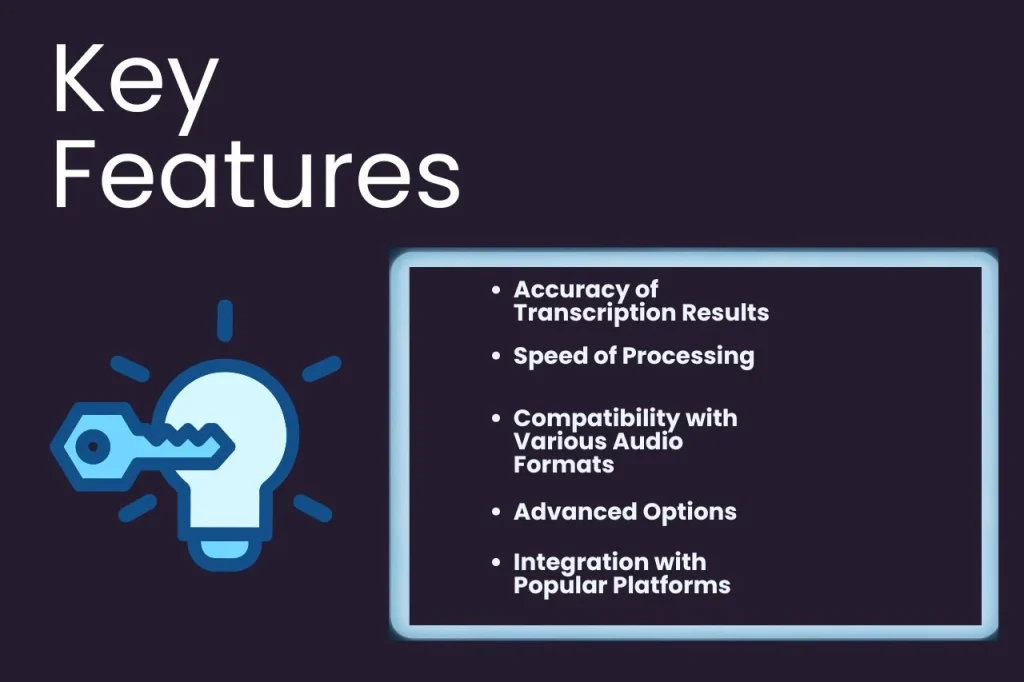
1. Accuracy of Transcription Results
The primary reason for choosing an AI Tool for Audible to Text is to obtain highly accurate transcriptions quickly. Therefore, accuracy is by far the most critical feature. Look for tools that deliver precise and reliable results, even from challenging audio. Here’s what to look for:
- Clear Word Recognition: The tool should be able to understand various accents, dialects, and even mumbling or unclear speech. High-quality transcription tools are equipped to handle fast speakers, overlapping speech, and background noise.
- Contextual Understanding: Beyond simple word-to-word transcription, a top-tier AI tool uses natural language processing (NLP) to understand the context of a conversation, ensuring that the transcription is not only accurate but also meaningful and relevant.
- Automatic Punctuation and Capitalization: Instead of leaving your transcript plain, look for a tool that can intelligently insert punctuation marks, capital letters, and formatting where necessary. This feature helps improve readability, making your transcript more polished and usable without requiring manual editing.
- Industry-Specific Accuracy: Some transcription tools are fine-tuned for specific industries like medical or legal transcription. If you work in a specialized field, check if the tool supports these industries with enhanced terminology recognition.
The more accurate the tool, the less time you’ll spend correcting errors, allowing you to focus on the content itself.
2. Speed of Processing: Real-Time vs. Batch Processing
How fast an AI Tool for Audible to Text processes your audio file can drastically impact your workflow. Transcription tools typically come in two main processing styles:
- Real-Time Transcription: Ideal for situations where you need quick results, such as live meetings, webinars, or podcasts. The transcription happens as the audio plays, allowing you to instantly capture and review the text. This feature is particularly useful for professionals who need to transcribe meetings or events in real-time without delays.
- Batch Processing: For longer audio files like interviews or podcasts, batch processing is often a better option. The tool can process large amounts of audio at once, generating text at high speeds once the file is uploaded. This method is perfect for post-production editing, as it allows you to transcribe large recordings without requiring immediate real-time results.
The key here is selecting a tool that fits your workflow—whether you need speed for live events or efficiency for longer files.
3. Compatibility with Various Audio Formats
When choosing an AI tool, make sure that it supports the types of audio files you work with most often. The more formats the tool can process, the more versatile it becomes. Here are some commonly supported formats:
- MP3: One of the most common and compressed audio file formats, great for podcasts, music, and online content.
- WAV: A high-quality, uncompressed audio format, ideal for professional recordings where clarity is important.
- AAC: Often used by Apple devices and streaming platforms, offering high-quality audio compression without losing clarity.
- FLAC: A lossless audio format that preserves the original quality of recordings, supported by some advanced transcription tools.
- M4A: Another compressed audio format commonly used for podcasts and music.
If you regularly work with recordings from different sources, look for a transcription tool that supports a wide variety of file types to avoid conversion issues.
4. Advanced Options: Speaker Identification and Editing Tools
While transcription accuracy and speed are essential, advanced features can take your experience to the next level. Here are some features you may want to look for:
- Speaker Identification: This feature automatically identifies different speakers in the audio, making it easier to follow the conversation. It labels each speaker as “Speaker 1,” “Speaker 2,” etc., which is crucial for interviews, podcasts, or meetings with multiple participants.
- Time-Stamps: For content like interviews, conferences, or podcasts, time-stamps show when each part of the conversation happens in the audio. This makes it easier to reference specific sections later, improving the efficiency of content review or editing.
- Built-in Editing Tools: Some AI transcription tools allow you to edit and fine-tune the transcriptions directly within the platform. You can adjust formatting, remove errors, and ensure that the transcription matches the intended meaning.
- Text Formatting Options: Advanced tools offer formatting options such as bullet points, headers, or bold text. These can help organize the transcription better, making it easier to review or share with others.
These advanced options add significant value, particularly for those who work with complex, multi-speaker audio files.
5. Integration with Popular Platforms like Zoom, Google Docs, or Microsoft Teams
For a seamless experience, it’s important to choose a tool that integrates smoothly with the platforms you already use. Here’s what to look for in integrations:
- Zoom Integration: Many transcription tools integrate directly with Zoom, allowing you to automatically transcribe meetings and webinars after they finish. This is incredibly helpful for capturing meeting minutes or transcribing important discussions.
- Google Docs and Microsoft Teams: Integration with Google Docs or Microsoft Teams allows for easy sharing and collaborative editing of your transcriptions. You can access your transcription in real-time from these platforms, ensuring smooth workflow for teams.
- Cloud Storage: Many AI transcription tools support cloud storage integrations, such as Google Drive or Dropbox. This ensures that your transcriptions are easily accessible and shareable across multiple devices.
The ability to connect your transcription tool to other platforms makes it a more powerful part of your content creation or collaboration process.
6. Security and Data Privacy Measures
Given the sensitive nature of many types of audio content, choosing a tool that prioritizes security and data privacy is crucial. Here’s what you should check:
- Data Encryption: Look for tools that encrypt both the audio files and the transcriptions. This ensures that no one else can access your data while it’s being processed.
- User Privacy Policies: Ensure the tool follows industry-standard privacy regulations, such as GDPR or CCPA, especially if you’re dealing with personal or confidential information.
- Control Over Your Data: The best tools give users control over their data, allowing you to delete or manage transcriptions after processing.
These features ensure that your data is protected and that you’re using a reliable, secure transcription service.
Pro Tip: Choose the Tool That Best Fits Your Needs
Every transcription need is different, so it’s essential to match the right tool to your specific requirements:
- For Business Meetings: Look for real-time transcription, speaker identification, and integrations with platforms like Zoom or Microsoft Teams to ensure efficiency and ease of use.
- For Podcasts: Choose tools with batch processing, advanced editing tools, and time-stamps for accurate, polished transcriptions.
- For Interviews or Research: Select a tool with high accuracy, speaker identification, and the ability to highlight key points to quickly reference quotes or segments.
By understanding and prioritizing these features, you can confidently choose an AI Tool for Audible to Text that fits your needs, improves productivity, and ensures accuracy. Whether you’re transcribing meetings, podcasts, or interviews, the right tool will save you time and effort, making your workflow more streamlined and efficient.
The Best AI Tool for Audible to Text: Our Top Picks
Selecting the best AI Tool for Audible to Text is crucial for ensuring high-quality and efficient transcription of your audio content. Below, we have highlighted the top transcription tools available, each excelling in specific areas such as real-time transcription, collaboration, or language support. This detailed comparison, along with website links, will help you make an informed choice based on your needs.
1. Otter.ai
Best for: Real-Time Transcription and Team Collaboration
Otter.ai is one of the most well-known transcription services, particularly praised for its real-time transcription capabilities and collaborative features. It’s perfect for users who need quick and accurate transcriptions during meetings, webinars, or interviews.
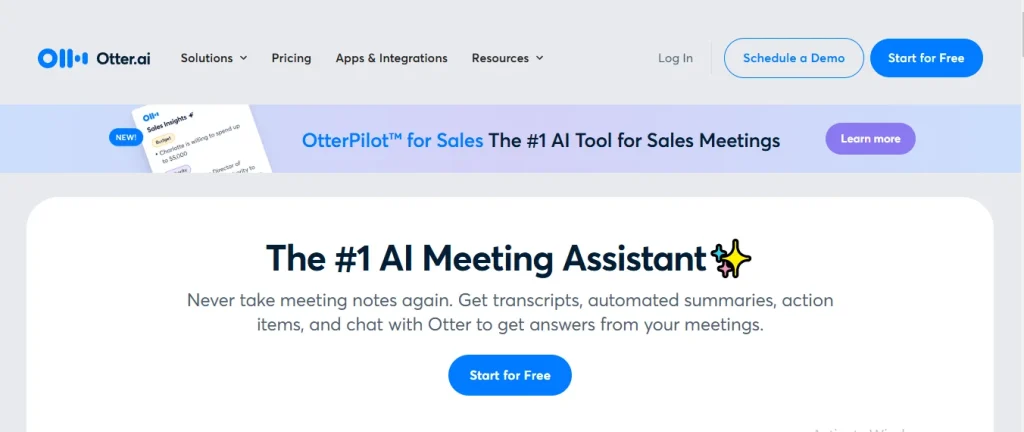
- Key Features:
- Real-time transcription: Ideal for live events, meetings, or webinars.
- Collaborative features: Share and edit transcripts with your team members.
- Integrations: Seamlessly integrates with Zoom, Dropbox, and Google Drive.
- Speaker identification: Automatically distinguishes different speakers.
- Why Choose Otter.ai:
If you’re looking for a tool that offers fast, accurate transcriptions for live meetings and events, Otter.ai is an excellent choice, especially for teams that need to collaborate.
2. Rev.com
Best for: High-Accuracy Transcription and Human Support
Rev.com is a versatile transcription tool that provides both AI-powered and human transcription options. It’s ideal for users who prioritize accuracy and need both automated and manual transcription services.
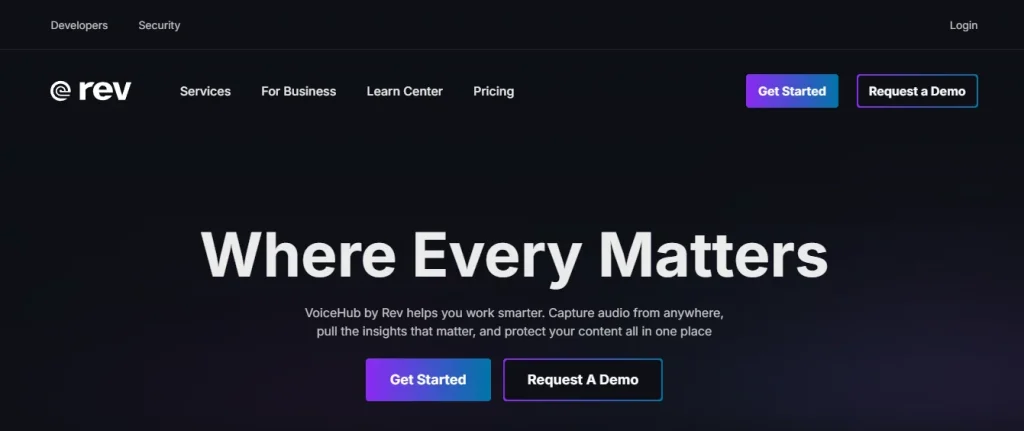
- Key Features:
- AI and human transcription: Choose between automated and manual transcription options.
- Fast turnaround: Receive transcriptions in as little as minutes or hours.
- High accuracy: Renowned for its precision, especially with complex audio.
- Subtitles and captions: Rev also offers video captioning and subtitling services.
- Why Choose Rev.com:
Rev.com is perfect for those who need guaranteed high-accuracy transcriptions and are willing to pay a little extra for human verification.
3. Sonix.ai
Best for: Multi-Language Support and Advanced Editing Features
Sonix.ai stands out with its multi-language support and advanced transcription editing tools. It’s great for international teams or anyone who needs to transcribe content in different languages while also needing powerful editing options.
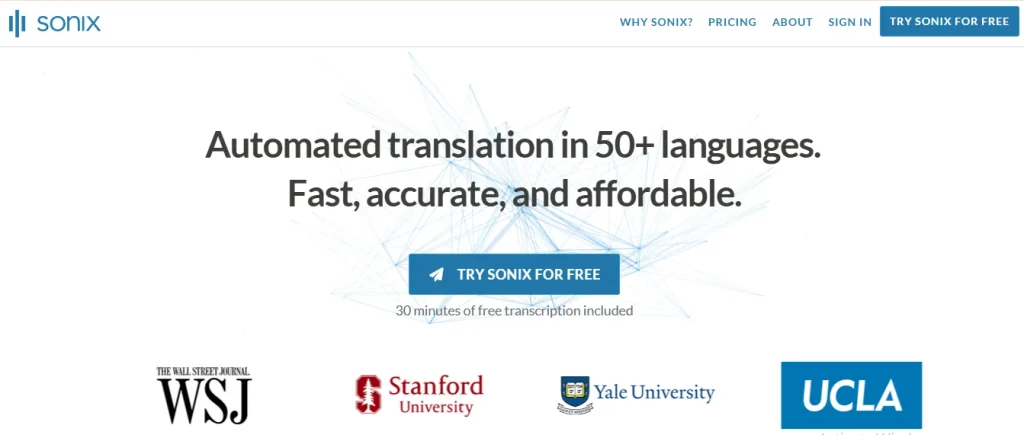
- Key Features:
- Supports 40+ languages: Transcribe content in multiple languages, perfect for global teams or diverse audiences.
- Powerful editing tools: Refine transcriptions with advanced text editing and organization features.
- Automatic punctuation: Ensures your transcript is readable and well-formatted.
- Integrations: Syncs with Google Drive, Dropbox, and other cloud services for easy file management.
- Why Choose Sonix.ai:
If you work in a multilingual environment or need advanced transcription editing features, Sonix.ai is the ideal tool to help you achieve high-quality transcriptions with ease.
4. Descript
Best for: Video and Audio Editing Along with Transcription
Descript is more than just a transcription tool; it’s a comprehensive video and audio editing platform that includes powerful transcription features. It’s perfect for content creators who need both transcriptions and editing tools in one platform.
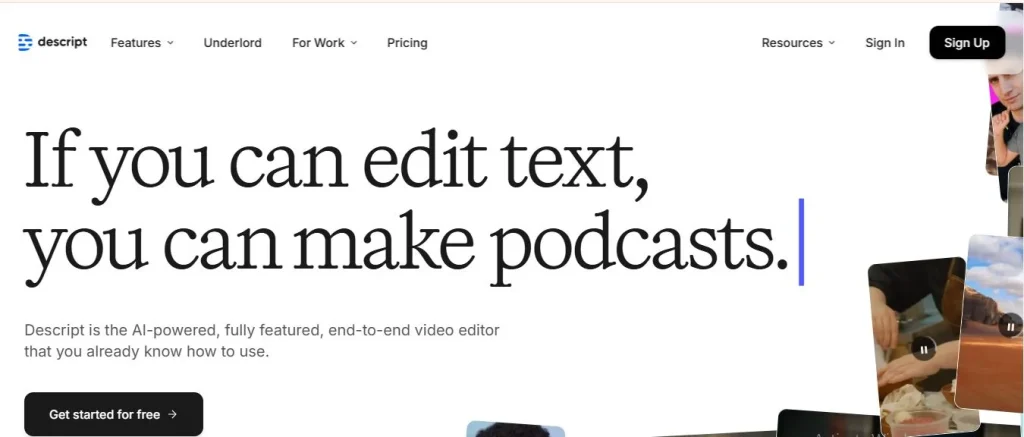
- Key Features:
- Video and audio editing: Edit audio and video directly within the platform, alongside transcriptions.
- Filler word removal: Automatically removes filler words like “um” or “ah” for cleaner transcriptions.
- Screen recording: Allows you to record your screen while transcribing or editing.
- Multi-user collaboration: Ideal for teams working together on content creation.
- Why Choose Descript:
For content creators, podcasters, or video producers, Descript offers an all-in-one solution for transcription and media editing.
5. Trint
Best for: Versatile Workflow and Integration with Creative Tools
Trint is a powerful transcription service known for its searchable transcripts and integration with creative platforms. It’s ideal for journalists, researchers, or media professionals who need to transcribe, search, and edit long-form content seamlessly.
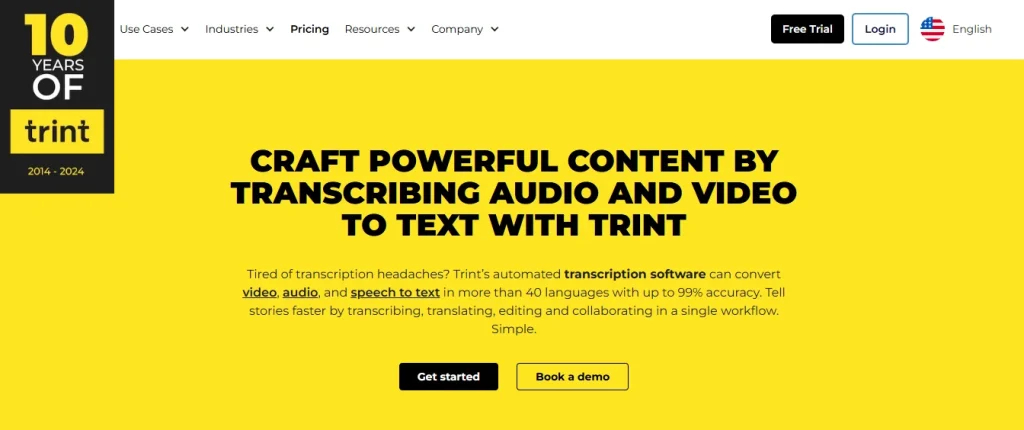
- Key Features:
- Searchable transcripts: Easily search for keywords and phrases in your transcription.
- Smart editing tools: Edit and improve transcription quality with automatic corrections.
- Video and audio syncing: Sync your transcription with the media for easy reference.
- Integrations: Works well with creative tools like Adobe Premiere Pro, Dropbox, and others.
- Why Choose Trint:
If you need a tool that integrates with your creative workflows and helps you efficiently manage long-form content, Trint is an excellent option.
Each of these AI Tools for Audible to Text has unique features that cater to different user needs. Whether you’re looking for fast, real-time transcription, advanced editing capabilities, or multi-language support, there is a tool that fits your specific requirements.
Pro Tip: Consider your main use case—if you need real-time transcription for meetings, tools like Otter.ai are perfect. For content creation, Descript offers a powerful combination of transcription and editing.
Explore the links provided to choose the right tool for your transcription needs, and streamline your workflow today.
Comparison Table of Top AI Tools for Audible to Text
| Tool Name | Key Features | Best For | Website |
|---|---|---|---|
| Otter.ai | Real-time transcription, speaker identification, integrations with Zoom and Google Meet | Professionals, meeting notes | Visit Otter.ai |
| Rev.com | AI and human editing options, high accuracy, supports multiple file formats | Journalists, accuracy-focused users | Visit Rev.com |
| Sonix.ai | Multilingual support, automated subtitles, cloud-based editing | Multilingual projects, video creators | Visit Sonix.ai |
| Descript | Audio-to-text with built-in editing tools, speaker detection, team collaboration features | Podcasters, video editors | Visit Descript.com |
| Trint | Automated transcription, collaboration-friendly, easy editing tools | Journalists, team projects | Visit Trint.com |
Step-by-Step Guide: How to Use an AI Tool for Audible to Text
Using an AI Tool for Audible to Text is an efficient and easy way to transcribe your audio content into text. Follow this simple guide to get started with transcribing your audio files accurately and quickly.
Step 1: Choose Your Preferred Tool
The first step is to select the right AI transcription tool. Some of the most popular tools include:
- Otter.ai: Best for real-time transcription and collaboration.
- Rev.com: Ideal for high-accuracy transcription with human support options.
- Sonix.ai: Perfect for multi-language support and editing features.
- Descript: Best for transcription with video and audio editing.
- Trint: Great for creative professionals looking for powerful editing and integration with media tools.
Choose a tool that best fits your needs—whether it’s for meetings, podcasts, or video interviews.
Step 2: Upload Your Audio File to the Platform
After selecting your tool, the next step is to upload your audio file. Most AI transcription platforms support various file formats, such as:
- MP3
- WAV
- AAC
- FLAC
Simply click the Upload button on the platform’s interface, and select the audio file from your device.
Step 3: Customize Settings
To ensure the most accurate transcription, you can customize the settings based on your needs. Some settings to consider include:
- Language: Choose the language in which your audio is recorded.
- Speaker Identification: Enable this feature if your audio has multiple speakers, so the tool can distinguish between them.
- Punctuation and Formatting: Some tools allow you to automatically format your transcript for readability.
Adjust these settings to match the type of audio you’re transcribing for optimal results.
Step 4: Wait for the AI to Process the File
Once your file is uploaded and settings are configured, the AI tool will begin processing the audio. This may take anywhere from a few minutes to longer, depending on the length of the audio and the platform you are using.
During this time, the AI analyzes the speech, identifies words, and converts them into text.
Step 5: Edit the Transcript (If Needed) and Export It
Once the AI has processed the audio, you’ll have a full transcript. However, there may be some minor edits needed for:
- Speaker identification: Ensure all speakers are correctly identified.
- Punctuation: Make sure the punctuation is accurate and the text is properly formatted.
- Text errors: Sometimes the AI may misinterpret words, so a quick edit will ensure the transcript is correct.
After reviewing and editing the transcript, you can easily export it in various formats such as PDF, TXT, or Word document.
Pro Tip: Use Audio Files with Minimal Background Noise
For the highest accuracy in transcription, it’s essential to use clear audio files with minimal background noise. Clean recordings ensure the AI tool can better detect the speech and transcribe it accurately, reducing the need for manual corrections.
By following these simple steps, you can quickly and efficiently convert your audible content into text using AI tools. Whether you’re transcribing meetings, interviews, or podcasts, this guide will help you make the most of your AI transcription tool.
Real-Life Use Cases for AI Tools for Audible to Text
AI tools for audible to text are incredibly versatile and can be used across a wide range of industries and for various personal needs. Whether you’re a content creator, student, or business professional, these tools can save you time, enhance productivity, and provide accessibility. Below are some real-life use cases where AI transcription tools can make a significant impact.
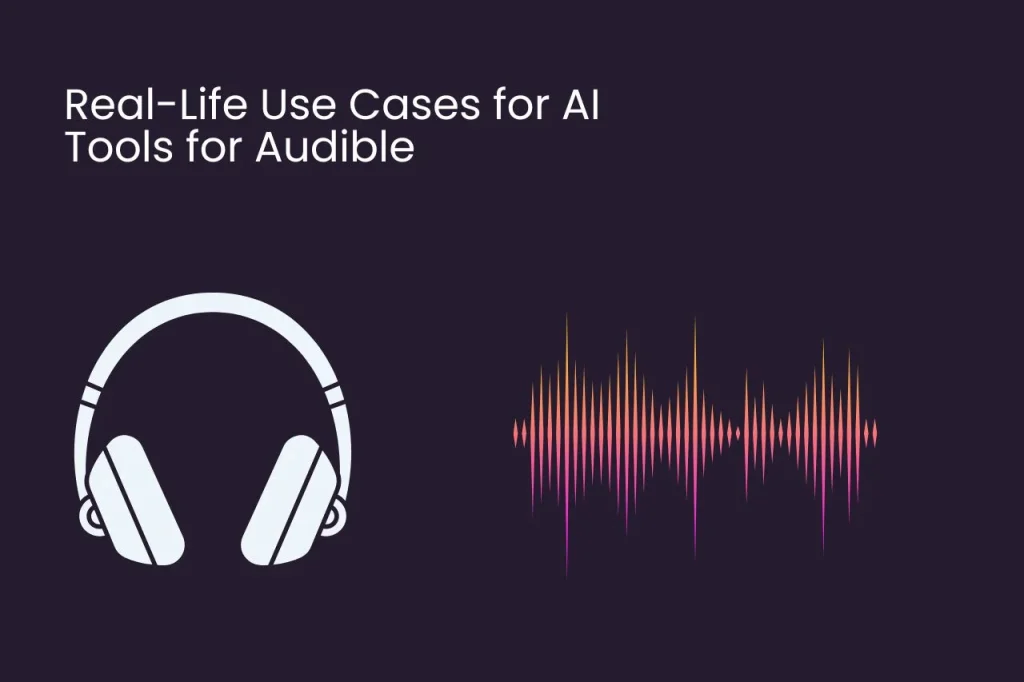
1. Content Creators: Convert Podcasts or Interviews into Blog Posts or Social Media Captions
As a content creator, turning audio content into written text can significantly expand your reach. Whether you’re podcasting or interviewing someone for your blog, AI transcription tools can help you quickly convert these sessions into blog posts, articles, or social media captions.
- Benefits:
- Boost content production: Save time on manual transcriptions and focus on creating more content.
- SEO advantage: Turn audio content into searchable written content that can drive organic traffic.
- Content repurposing: Repurpose podcasts or interviews into other formats like articles or social media posts.
By using AI transcription tools, you can quickly convert your interviews and podcasts into engaging written content.
2. Students: Transcribe Lectures for Effective Study Notes
AI transcription tools are invaluable for students who need to keep track of lectures, seminars, and discussions. Instead of manually writing notes, students can simply upload their recorded lectures to the transcription platform and receive accurate transcripts.
- Benefits:
- Accurate and reliable notes: No more missing key points during class.
- Better study material: Have a complete and structured set of lecture notes for future reference.
- Time-saving: Spend less time transcribing and more time reviewing or studying the material.
AI tools can improve the study experience by providing transcriptions that are easy to review and refer to.
3. Businesses: Generate Meeting Minutes and Presentations
For businesses, AI transcription tools can streamline the process of documenting meetings, presentations, and brainstorming sessions. With accurate transcriptions, you can ensure no critical points are missed, and easily create meeting minutes or reports.
- Benefits:
- Efficient meeting documentation: Get automatic meeting minutes or summaries without the need for manual note-taking.
- Improved collaboration: Share transcripts with team members for better follow-ups and discussions.
- Record keeping: Maintain a written record of meetings for future reference or legal purposes.
AI tools help businesses save time and maintain organized, accurate records of meetings.
4. Journalists: Quickly Transcribe Interviews and Press Conferences
For journalists, time is of the essence when transcribing interviews and press conferences. AI transcription tools can quickly convert spoken words into written text, allowing journalists to focus more on analyzing the content rather than writing it out manually.
- Benefits:
- Fast transcription: Turn hours of audio into text in minutes.
- Accuracy and clarity: Capture quotes and important information with minimal errors.
- Efficient workflow: Speed up your work process by eliminating the need for manual transcription.
For journalists, AI transcription tools ensure fast, accurate, and easy conversion of interviews and events into useful written material.
5. Accessibility: Help Individuals with Hearing Impairments by Providing Text Versions of Audio Content
AI transcription tools play a crucial role in making audio and video content accessible to people with hearing impairments. By providing text versions of podcasts, lectures, and videos, these tools help ensure that everyone has equal access to important information.
- Benefits:
- Improved accessibility: Provide written content for audio and video media.
- Enhanced inclusion: Allow individuals with hearing impairments to access critical information.
- Comprehensive support: Make content more inclusive for all audiences by offering multiple formats.
AI tools help bridge the gap for those who have difficulty hearing, ensuring that no one is excluded from important content.
AI tools for audible to text are incredibly beneficial across various fields, helping to improve efficiency, accessibility, and productivity. Whether you’re a content creator, student, business professional, journalist, or part of a community requiring accessibility, AI transcription tools offer valuable solutions to meet your needs. By embracing these tools, you can save time and focus on what matters most—whether it’s creating content, studying, or collaborating effectively.
Tips & Tricks for Getting the Best Results with AI Tools for Audible to Text
To get the most accurate and efficient transcription results from your AI Tool for Audible to Text, follow these expert tips and tricks. By ensuring clear audio, choosing the right tool, and using editing and integration strategies, you can achieve optimal results every time.
1. Ensure Clear Audio
The quality of your audio plays a crucial role in the accuracy of the transcription. Clear, high-quality audio will make it easier for the AI tool to accurately transcribe spoken words.
- Use High-Quality Microphones: Invest in a good microphone for crystal-clear sound. The better the microphone, the better the transcription accuracy.
- Avoid Background Noise: Record in a quiet environment to reduce background noise and distractions. If possible, use noise-canceling equipment.
- Position the Microphone Properly: Make sure the speaker is close enough to the microphone for clear audio capture.
By ensuring clear audio, you give your transcription tool the best chance for accuracy.
2. Choose the Right Tool
Not all transcription tools are the same. Choosing the right AI tool depends on your specific needs.
- Real-Time Transcription: If you need live transcription during meetings or webinars, select a tool like Otter.ai.
- Language Support: For multilingual content, choose a tool with language support like Sonix.ai or Trint.
- Advanced Editing: If you require additional editing features, Descript or Rev.com might be the best fit.
Make sure to select a tool that aligns with your primary needs for the best results.
3. Edit the Transcription
While AI tools are great at transcribing, no tool is perfect. Even the most advanced systems may miss words or make mistakes, especially in noisy environments.
- Review the Output: After transcription, go through the text to check for any errors, missed words, or formatting issues.
- Edit for Clarity: Edit sentences where the AI may have misunderstood or misheard certain words, especially in challenging accents or speech patterns.
Editing is a key step to ensure the transcript is polished and fully accurate.
4. Use Headphones
Before uploading audio files to the transcription tool, it’s important to check the audio quality.
- Test Audio Quality: Use headphones to listen to the audio and check for any distortion, noise, or issues that might affect transcription quality.
- Adjust Settings: If needed, adjust the recording levels or use audio enhancement software to improve sound quality before uploading.
By listening with headphones, you ensure that your audio file is ready for the best possible transcription.
5. Take Advantage of Integrations
Many transcription tools integrate seamlessly with other productivity apps, which can enhance your workflow and make it easier to manage your transcriptions.
- Sync with Google Docs or Slack: For example, tools like Otter.ai integrate with Google Docs for easy editing and sharing.
- Use Cloud Storage: Sync your transcription tool with Dropbox or Google Drive to store and organize your transcriptions in the cloud.
- Collaborate Easily: Share your transcriptions with team members in real-time, making it easier to collaborate on projects.
Integrations save time and help you work more efficiently by connecting transcription tools with your other digital platforms.
Pro Tip: Run Short Audio Tests Before Transcribing Longer Files
Before jumping into transcribing longer audio files, always run a short audio test with the transcription tool. This allows you to assess the tool’s accuracy and performance with your specific audio content.
- Test for Accuracy: Ensure the tool transcribes the content accurately with your recording type.
- Evaluate Speed: Check how quickly the tool processes shorter clips and ensure it fits within your workflow.
This simple step can save time and help you avoid frustrations later when transcribing larger files.
By following these tips and tricks, you can get the best possible transcription results from your AI Tool for Audible to Text. Whether you’re working with podcasts, meetings, lectures, or interviews, these strategies will help you achieve fast, accurate, and efficient transcriptions.

FAQs about AI Tool for Audible to Text
What is an AI Tool for Audible to Text?
An AI Tool for Audible to Text is a software that uses artificial intelligence to convert audio recordings into written text. It leverages speech recognition technology to analyze audio and transcribe it into accurate, readable text in real time or after processing.
How accurate is an AI Tool for Audible to Text?
The accuracy of an AI Tool for Audible to Text depends on several factors, such as the quality of the audio and the clarity of speech. Most AI transcription tools are highly accurate but may need minor editing, especially in noisy environments or with heavy accents.
Can I use an AI Tool for Audible to Text for podcasts?
Yes, you can use an AI Tool for Audible to Text to transcribe podcasts. Simply upload your podcast file to the tool, and it will quickly convert the audio into text. This is an excellent way for podcast creators to repurpose content into blog posts, show notes, or captions.
How long does it take to transcribe audio with an AI Tool for Audible to Text?
The time it takes to transcribe audio using an AI Tool for Audible to Text varies depending on the length of the file and the tool’s processing speed. On average, short files may be transcribed in minutes, while longer files could take a bit longer. The best tools can provide near real-time transcriptions.
Can I use an AI Tool for Audible to Text for transcription of interviews?
Yes, an AI Tool for Audible to Text is ideal for transcribing interviews. It can quickly convert recorded interviews into text, allowing you to focus on analyzing and sharing the content. Many tools also offer features like speaker identification, making them perfect for transcribing conversations between multiple people.
How do I choose the best AI Tool for Audible to Text?
To choose the best AI Tool for Audible to Text, consider factors like accuracy, supported audio formats, processing speed, and additional features like speaker identification or real-time transcription. Make sure the tool fits your specific needs, whether it’s for business meetings, podcasts, or academic lectures.
How do I ensure privacy when using an AI Tool for Audible to Text?
To ensure privacy, choose an AI Tool for Audible to Text that offers robust data protection features, such as end-to-end encryption and compliance with data privacy regulations like GDPR. Always review the tool’s privacy policy and terms of service to ensure that your data is handled securely.
Is there a limit to the length of audio I can upload to an AI Tool for Audible to Text?
The length of audio you can upload to an AI Tool for Audible to Text depends on the tool’s features. Many tools offer different limits for free vs. paid plans, with paid versions typically allowing longer files. Check the guidelines for your chosen tool to determine any limits or restrictions.
How can an AI Tool for Audible to Text help content creators?
An AI Tool for Audible to Text can save content creators a significant amount of time by converting their podcasts, interviews, or video audio into text. This text can be repurposed for blog posts, show notes, social media content, or even transcriptions for subtitles. It streamlines content creation and maximizes content reach.
How do I ensure the accuracy of transcriptions using an AI Tool for Audible to Text?
To ensure the accuracy of transcriptions with an AI Tool for Audible to Text, make sure the audio quality is clear, avoid background noise, and use high-quality microphones. Additionally, review and edit the transcriptions as needed, especially in noisy environments or when multiple speakers are involved.
Conclusion: Unlock the Power of AI for Audible to Text
Transcribing audio can be a time-consuming and tedious task, but with an AI Tool for Audible to Text, you can save valuable time, improve accuracy, and boost productivity. These tools provide fast, reliable transcription, allowing you to focus on other important tasks while the AI handles the heavy lifting.
Why You Should Use an AI Tool for Audible to Text
- Save Time: Traditional transcription methods take hours, but AI tools convert audio into text in minutes, freeing up your time for other essential tasks.
- Accuracy: AI transcription tools are designed to provide highly accurate text, minimizing the chances of human error and ensuring you get the right results.
- Boost Productivity: With faster and more efficient transcriptions, you can work more effectively, whether you’re transcribing podcasts, meetings, or lectures.
Take Action: Try an AI Tool for Audible to Text Today!
Don’t let transcription slow you down! With the AI Tool for Audible to Text, you can unlock greater efficiency and precision in your workflow. Whether you’re a content creator, business professional, or student, these tools can help you stay ahead.
Take the Next Step:
“Don’t let transcription hold you back! Try one of these tools today and experience the power of AI at your fingertips.”
Take the leap into faster, more accurate transcription and transform your workflow with the best AI tools available!
Explore More Free AI Tools
How to use perchance AI Image Generator
How to Use Pictory AI for Free
Jasper AI Best Budget-Friendly Writing Tool
Unlock Writesonic AI for Free Step-by-Step Tutorial
Free AI Tool to Create Passport Photos in Minutes with AI Ease
AI Image Generator No Restrictions Unlock Limitless Creativity
How to Use Quetext Free Plagiarism Checker Like a Pro
How to Choose the Perfect AI Tool for Law Students A Complete Guide
Unleash the Power of AI Rapper Voice Generator Today
Felo AI Tool Unlock Smarter Searches with This Revolutionary Innovation
Top 10 Tree Map AI Tool Options for Smarter Data Visualization in 2025
How to Use ChatGPT Image Generator Free for Mind-Blowing Visuals
Best AI Music Creation Tools for Artists and Creators in 2025
AI Tool for Formal Methods Top Tools, Applications, and Step-by-Step Guide
Top 5 Song to Video AI Software Tools to Supercharge Your Creativity
Top 7 AI Newsletter Generator Design Tools to Power Up Your Marketing
Newsletter Signup
“Subscribe to our newsletter for weekly updates on the latest AI tools, tips, and trends to boost your skills!”



